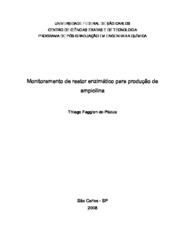Monitoramento de reator enzimático para produção de ampicilina
Abstract
This work is part of a research project in DEQ-UFSCar (Department
of Chemical Engineering at Federal University of São Carlos, Brazil). The focus is
to develop a competitive industrial enzymatic process to obtain semi-synthetic β-
Lactam antibiotics. This process rivals with the conventional one, which uses toxic
solvents and generates non-recyclable residues. Thus, the increasing rigor of
environmental regulations is an important driving force for the research.
The enzymatic production of ampicillin, in aqueous medium, uses a
derivate from an acyl donor (in this work, D-phenylglycine methyl ester, PGME)
and 6-aminopenicillanic acid (6-APA). Penicillin G acylase (PGA) is usually the
biocatalyst for this process. Unfortunately, PGA acts either as transferase,
producing ampicillin (AMP), or as hydrolase, producing D-phenylglycine (PG) from
PGME (and from ampicillin). This is a series-parallel reaction scheme, with the
antibiotic being the desired intermediate product.
This work studied the use of multivariate calibration in a
spectrophotometer for on-line monitoring the enzymatic synthesis reactor. High
Performance Liquid Chromatography (HPLC) is the usual analytical procedure,
which is time demanding, expensive and generates amounts of disposals.
Multivariate calibration, on its turn, only uses dilutions of reactor samples and a
spectrophotomer (with UV detector). Some multivariate calibration techniques
(SPA, PCR, PLS) were tested and compared. They didn t show representative
differences in cross-validations or in test data.
The work also focused the automation of a reactor and its
accessories, where the enzymatic production of ampicillin and 6-APA (after
Penicillin G enzymatic hydrolysis) takes place. The software was implemented in
LabVIEW (National Instruments), which controls the Automatic Sampler (AS) for
multivariate analysis, among other equipments. The development of this system
provided a real-time concentration response from the reactor, for all chemical
species. Following an optimal trajectory in the enzymatic reactor by adding
reactants is one of the most important strategies to reach a competitive process.
Hence, the concentration sensor represents an important step for the feasibility of
the enzymatic process, because it could be used to monitor and control the
concentrations of substrates during the industrial feed-batch.
Several assays, among then batch and fed-batch runs, were done
and many modifications on the experimental scheme were implemented or
proposed. Some of these assays could be treated as validation of monitoring
software and concentration sensor, which showed good results.
